Home » Playing Time Guidelines
This policy is specific to the not-for-profit competitive teams stream. It describes the importance of coaches’ autonomy to make the best decisions for player and team development throughout the season, and also to make the tough decisions that are intended to propel the team to success at critical competitions, particularly at the Provincial and National Championships.
The primary goal of the Maverick Volleyball Club is to help each athlete improve and ultimately develop to his or her full potential. The goal of every team is to perform as best they can as a group. Depending on the seasonal phase and the importance of the competition, a secondary goal might be to provide playing opportunities, or to work on a particular skill in a competitive environment, or to try to obtain the best possible result.
Regardless of the specific goal, playing time is earned through focus and hard work at practice, in weekly physical training, and demonstrated ability on the court. Regardless of the roles that evolve over the season, all players and parents are expected to remain positive and committed to having each player develop to his or her maximum potential.
It is with that starting point that the Club has developed this 3-principle policy (Practice Opportunities, Playing Opportunities, Good Planning) to help coaches, athletes and parents make choices that support their athletic development and ensure that each athlete is getting a sufficient quantity and quality of opportunities to improve during practices and competitions. As an organization, we stand behind the autonomy of our coaches to make decisions on what is best for the players and the team while following the playing time guidelines below.

Level 1 – Participation based (equitable playing time)
Level 2 – Participation based in pool play to ABC performance in playoffs
Level 3 – ABC performance in pool play to Role performance in playoffs
Level 4 – Role performance at all stages
ABC performance – two squads are created and each squad plays one set. In the event a third set is to be played, the team that won their set plays, or a combination of players from both squads (A & B) will play.
Role performance – players are selected based on the role needed for the match, their performance to date, and overall contribution to the team.
Athletes need sufficient quantity & quality practice opportunities to develop.
Coaches should endeavor to provide equitable practice opportunities for all players. These opportunities should also be of similar quality. Quality varies based on the strength of athletes involved, the challenge and the importance of the playing opportunity. This is of particular importance when dealing with collective drills. Coaches have achieved success when all players are comfortable playing with each other as they have regularly participated in drills together.
Coaches also have the responsibility to prepare athletes to take on roles during matches. Coaches should ensure athletes have practiced in a role before being asked to perform in that role during a match.
Athletes develop and learn through sufficient quantity and quality playing opportunities.
Coaches must identify three tournaments where the goal of player development is the priority. One of the tournaments must be an Ontario Volleyball Association event and one of the tournaments should be ideally in or around the championship phase of the season. These tournaments can be used to:
Good tournament management will maximize player development.
Coaches should develop a competition plan that respects the training to competition ratio of Volleyball Canada’s Long Term Athlete Development Model. As well, competition plans should be designed to maximize player development using the following playing-time continuum:

